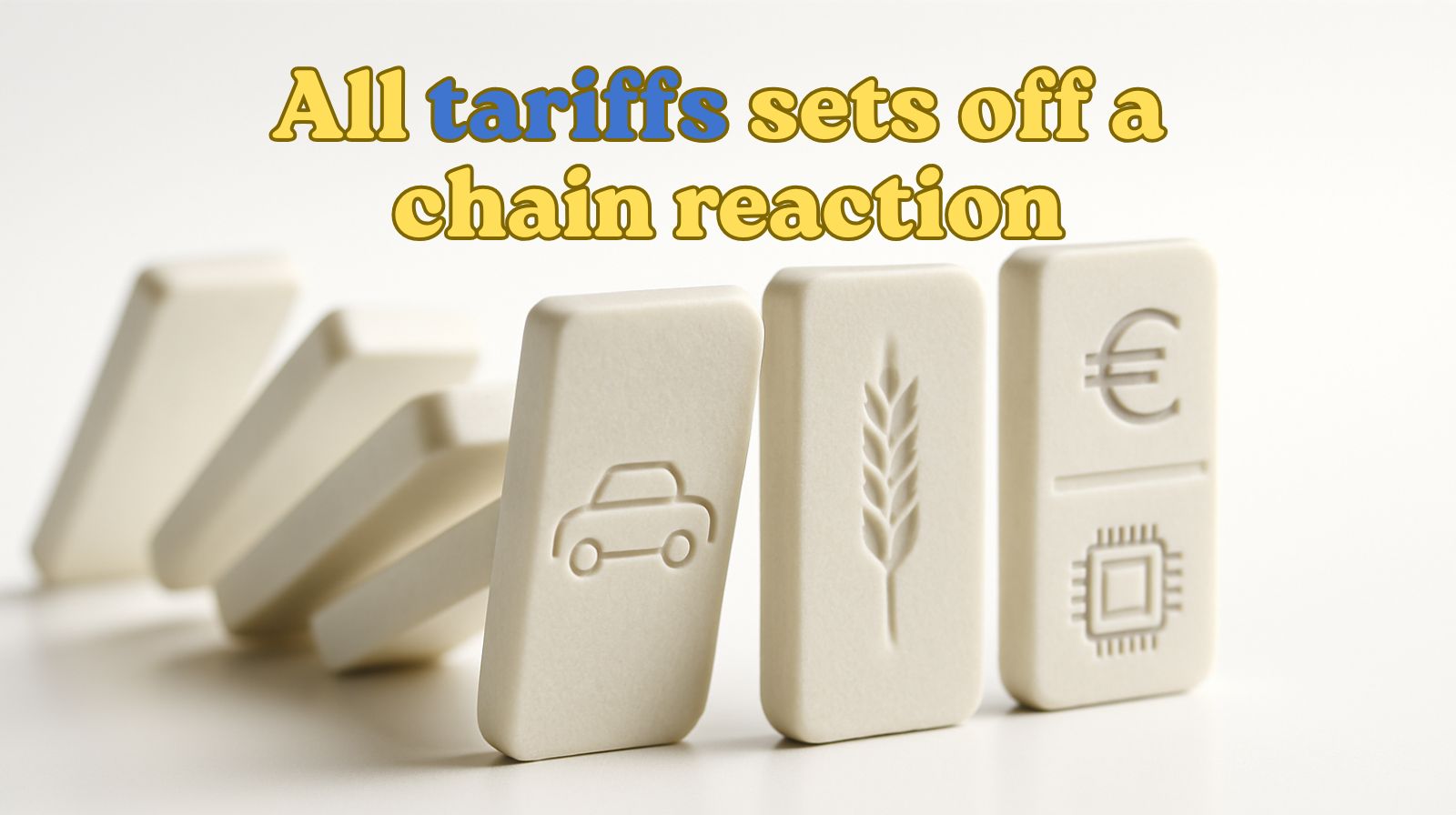- The Bread Bin
- Posts
- How Tariffs Shape Global Markets
How Tariffs Shape Global Markets
Tariffs act like invisible toll gates that redirect profits and rewrite global supply chains. Here’s how smart investors stay one step ahead of the changes.

Tariffs are like invisible toll gates placed between nations. They shape what gets built, bought, and invested in. This article unpacks how tariffs ripple through economies, shift company fortunes, and ultimately reach the everyday investor.
This is the first in a four part series exploring how tariffs shape our world, from the big global forces to the impact on everyday investors.
Part One explains what tariffs really are and how they ripple through global markets.
Part Two looks at the new U.S. policy under President Trump and its global fallout.
Part Three explores how tariffs change the investment landscape and where new opportunities emerge.
Part Four brings it home, showing how tariffs affect the prices we pay and the portfolios we build.
Why It Matters
Every trade decision, from the price of a phone to the profit margin of a factory, travels through the invisible web of tariffs. They can raise prices, squeeze company profits, or redirect global supply chains overnight.
Think of tariffs as stones dropped in a pond. The first splash hits exporters, but the ripples spread to manufacturers, shop owners, and investors holding shares in those companies. When one country raises barriers, others often respond, creating a feedback loop that reshapes who wins and who loses.
In the short term, tariffs can look like a quick fix for domestic jobs. But in the long term, they often raise production costs and fuel inflation. The irony is that they are meant to protect local industries but can end up squeezing the very consumers they aim to defend.
For investors, understanding tariffs is not about predicting politics. It is about seeing the chain reaction. Who gets priced out, who adapts fastest, and where new opportunities quietly emerge.

One tariff decision can start a chain reaction that touches every corner of the economy.
Investor Rationale
When discussing this internally we get different takes, all pointing to the same truth. Stay rational and stay observant.
Never forget to focus on businesses with moats. These are companies so solid they can adapt to rising costs or find new suppliers without losing customers. They point to firms that make essentials, not luxuries, things people buy even when prices rise.
When you head to the supermarket look at other peoples shopping basket. This tells you products people cannot do without irrespective of price. Do you notice changes in your local store. Are foreign brands get pricier, do domestic brands suddenly gain shelf space, if so their share prices often follow.
Follow the flow. When one door closes, trade finds another. Factories do not vanish, they move om, often to the next cheapest and most stable location. Be vigilant, it could pay you big.
If you’re patience enough, wait quietly until everyone panics, then buy. Tariffs can create opportunity. Temporary fear leads to mispricing, and mispricing leads to profit for those with patience.
Evidence and Metrics
The numbers tell a story most people never hear. According to the World Trade Organization, global trade growth slowed by around three percent in 2024, and much of that drag came from tariffs and supply chain tensions. It is like a traffic jam on the world’s biggest motorway. One lane closes, and everyone slows down.
When the United States added steel and aluminium tariffs a few years back, domestic producers saw prices jump by roughly twenty to twenty five percent.
That sounds like a win, but it also meant higher costs for every car maker, builder, and manufacturer using that steel. Tariffs may protect one corner of the economy but often pinch another.Even at the supermarket level, the impact trickles through. Electronics, cars, and home goods absorb tariff costs like a sponge.
That is one reason inflation does not always behave logically. Policy shocks quietly hide inside price tags.
But here is the twist. Tariffs also create winners. As companies move production to avoid fees, emerging markets like Vietnam, Mexico, and India have quietly gained new manufacturing contracts and foreign investment.
So while one region slows, another accelerates. The smart money follows where the factories go.

Tariffs tug at the invisible threads connecting every product, factory, and fortune.
Risks and Counterpoints
Tariffs may sound like policy tools, but in practice, they are emotional dominoes. One government raises barriers, another retaliates, and soon investors are watching headlines instead of fundamentals.
Political unpredictability becomes the biggest risk. It is like playing chess where the rules can change mid game.
Then there is currency movement. Tariffs can push currencies up or down depending on who gets hurt most.
If imports slow, demand for foreign currency falls, which can make the local currency stronger. That is not always good for exporters. It is one of those invisible side effects that quietly changes company valuations.
And finally, the consumer squeeze. Higher import costs eventually find their way into everyday items such as cars, furniture, and food.
As prices rise, demand can soften, especially in retail or leisure industries. The very measures meant to protect domestic jobs can end up reducing spending power at home.
That is why seasoned investors treat tariffs not as disasters but as filters. They reveal which companies truly understand their costs, their customers, and their supply chains, and which are simply riding luck.
What a Smart Investor Would Do Next
Track where factories move. Countries that absorb redirected production often gain new investment opportunities.
Focus on pricing power. Companies that can pass on costs without losing demand are long term winners.
Stay diversified. Tariffs create short term volatility but also long term bargains, especially in regions that benefit from supply chain shifts.
Already subscribed, then you don’t have to do anything except enjoy our great content.
Want to see which sectors quietly benefit from global tariff shifts?
Subscribe for next week’s deep dive into the real winners and losers. Sign up for the free newsletter today.
Quick favour - what part of today’s post stuck with you?
The story, or the takeaway? If you think a mate would get something out of it too, hit the share button at the top of the page and pass it on.
We’re trying to give as many people as possible, the chance to make their money work harder.
⚠️ Disclaimer:
This is for educational purposes only, and is not financial advice. Always do your own research before making investment decisions.